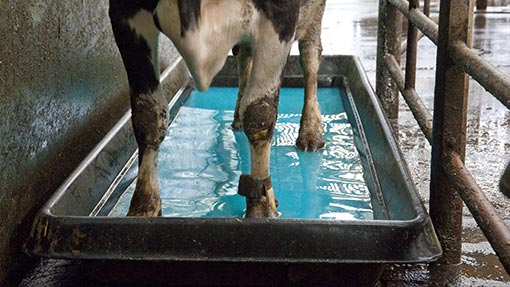8 steps to improve dairy herd foot-bathing regime

As a dairy cow is the most significant reservoir for digital dermatitis infection, effective foot-bathing is vital in tackling lameness by cleaning and disinfecting the hoof.
Dirty foot-baths not only harbour bacteria, but create ideal skin conditions for them to take hold, warns Owen Atkinson from the Dairy Veterinary Consultancy.
“The rule of thumb is one cow passage for every litre of solution. However, this can vary depending on how dirty the cows’ feet are; 200 cows should need 200 litres. If 300 cows go through 200 litres, the last 100 will be going through a slurry bath.
“The bugs can’t survive to breed in the slurry, but they do live long enough to be spread onto other cows in the herd. Constant wetness damages the skin, allowing bacteria in,” he says.
See also: Latest research on foot-bathing and lameness
Eight-point fitness test
The eight-point foot-bath fitness test is designed to get foot-bathing working to maximum effect while minimising the disadvantages, for example cost, time and effort, says Mr Atkinson.
- Examine cow flow: Cows need to walk steadily and willingly through the bath – those moving through quickly may splash their teats. Wider baths and those on parlour exits prevent congestion.
- Chemical choice: See foot-bathing regime table.
- Dilution rate: See foot-bathing regime table.
- Degree of chemical contact with foot: 12cm-deep solution is needed to get full contact with the whole foot. An ideal length of 3m should allow two dips for each foot. A 50cm-wide bath reduces solution volume, but may affect cow flow.
- Longevity of the foot-bath solution: One cow passage for every litre of solution. Have a clean entrance and exit, pre-bath or pre-wash feet.
- Frequency of bathing: See foot-bathing regime table.
- Animals to be bathed: Pre-calving and dry cows should go through as well.
- Ease of filling and emptying: Self-emptying and self-filling foot-baths are best for large herds. Set the limit so the bath is kept clean.
| Foot-bathing regimes | ||
|---|---|---|
| Chemical in bath | Use | Frequency and concentration |
| Antibiotic | Treating digital dermatitis | As directed by your vet |
| Formalin (1) |
Weekly ‘treatment’(3) Daily disinfectant |
Three consecutive days at 5% Daily at 5% |
| Copper sulphate (2) |
Weekly ‘treatment’ Daily disinfectant |
One to two days/week at 5% Daily at 2% (add mild, dilute acid) |
| Peracetic acid | Daily disinfectant | Daily at 1%- never miss treatment |
| Hypochlorite | Daily disinfectant | Daily at 2%- never miss treatment |
| Parlour wash | Daily disinfectant | Final rinse – never miss treatment |
| (1) Health and safety precautions must be followed
(2) Seek advice on land toxicity (3) Treatment for digital dermatitis, foul, heel erosion and to some degree, soft soles from new concrete Source: www.nadis.org.uk |
||
Owen Atkinson on foot-bathing in the robot setup
Foot-baths located on the exit to robots can sometimes put cows off from being milked.
One solution to this is to install a permanent foot-bath in one cross-over passage between the cubicles and feed fence.
The downside to this is cows may pass through seven to eight times a day, greatly reducing the longevity of the solution, at great expense.
However, if the foot-bath is inaccessible to cows until such time as the farmer actively runs the herd through, savings can be made.
To do this, all cows must be shut cubicle side and all cross-overs closed off. The foot-bath passage can then be opened up after filling the feed troughs.
All cows will then pass through to access the feed fence and the farmer knows they have all been through. Mr Atkinson recommends this process is repeated three times a week.
